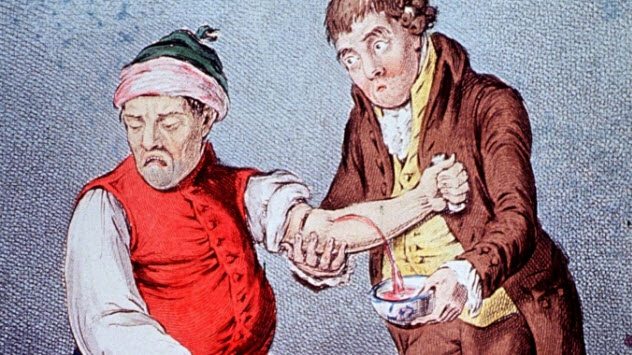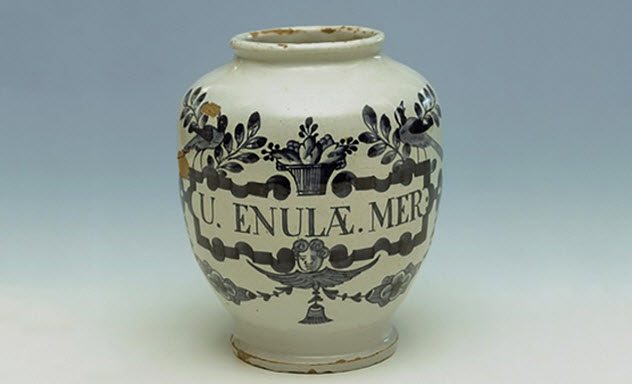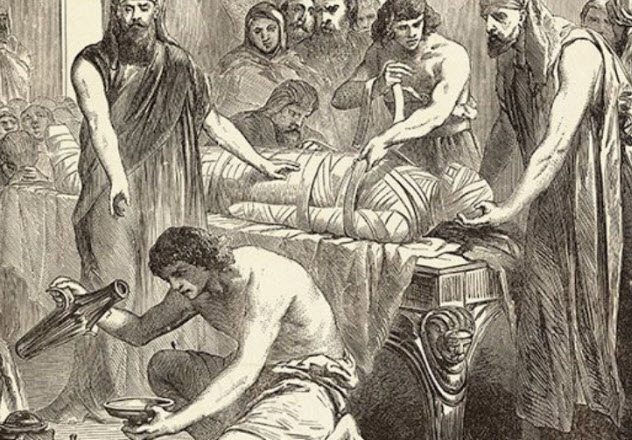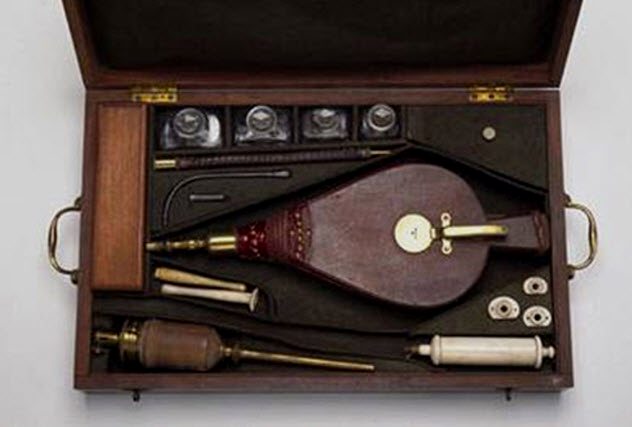 Weird Stuff
Weird Stuff  Weird Stuff
Weird Stuff  Mysteries
Mysteries 10 Tragic Disappearances and Deaths in Joshua Tree National Park
 History
History 10 Ways Childhood Really Sucked in the Old West
 Music
Music 10 Name Origins of Famous Bands from the 1990s
 Religion
Religion 10 Biggest Turnarounds by the Catholic Church
 Weird Stuff
Weird Stuff 10 Unbelievable Times Laws Had Unintended Consequences
 Humans
Humans Ten Historic Women Who Deserve Way More Credit Than They Got
 Movies and TV
Movies and TV 10 Films That Spawned Major Lawsuits
 History
History Ten Times Towns Were Wiped Off the Face of the Earth
 Creepy
Creepy 10 of the Most Disturbingly Haunted Public Houses in the UK
 Weird Stuff
Weird Stuff 10 Niche Subcultures That Are More Popular Than You Might Think
 Mysteries
Mysteries 10 Tragic Disappearances and Deaths in Joshua Tree National Park
 History
History 10 Ways Childhood Really Sucked in the Old West
Who's Behind Listverse?

Jamie Frater
Head Editor
Jamie founded Listverse due to an insatiable desire to share fascinating, obscure, and bizarre facts. He has been a guest speaker on numerous national radio and television stations and is a five time published author.
More About Us Music
Music 10 Name Origins of Famous Bands from the 1990s
 Religion
Religion 10 Biggest Turnarounds by the Catholic Church
 Weird Stuff
Weird Stuff 10 Unbelievable Times Laws Had Unintended Consequences
 Humans
Humans Ten Historic Women Who Deserve Way More Credit Than They Got
 Movies and TV
Movies and TV 10 Films That Spawned Major Lawsuits
 History
History Ten Times Towns Were Wiped Off the Face of the Earth
 Creepy
Creepy 10 of the Most Disturbingly Haunted Public Houses in the UK
10 Of The Most Weird And Macabre Medical Practices Of All Time
Fortunately, we live in a world with modern medicine. Usually, we can rely on our doctors to make or keep us well. But this hasn’t always been the case. A lot of bad diseases and viruses wiped out entire populations before the invention of antibiotics, antiretroviral drugs, vast medical and anatomical knowledge, and many more marvels of today.
Along the way, there was a great deal of medical trial and error and many people suffered as a consequence. These treatments often caused disastrous results that outweighed any potential benefits. Here are 10 of the most macabre medical treatments history has ever known.
10 Bloodletting

Bloodletting is an old, macabre medical practice that’s been around for millennia. A physician “lets the blood out of” (drains) a living patient to cure an ailment or disease. This is usually based on completely bunk medical knowledge.
Sometimes, bloodletting managed to help people battling various illnesses—for instance, obese people dealing with metabolic issues. Usually, though, it hurt more than it helped.[1]
The procedure is fairly straightforward and simple, even though it will make you squeamish if you aren’t fond of the sight of blood. You take a lancet, knife, razor, or any sharp object and cut open a vein, usually on the patient’s arm.
The physician would then place a collecting device, such as a bucket, below the patient to catch the draining blood. While the intention was to draw out pathogens, viruses, evil spirits, and more, the usual consequence was simply draining blood from the already suffering victim and further weakening his already compromised immune system.
One can almost imagine a medieval scene with a sick person groaning in agony, arm stretched out while a physician takes a knife and cuts the person open to collect his blood in a bucket below him.
9 Plastic Surgery

In the West these days, plastic surgery is an afternoon off and a minor investment. It’s so common that we almost consider it a rite of passage, even among teens and preteens. A little bit of anesthetic and some painkillers and you can look how you’ve always wanted.
But such surgery wasn’t always an easy experience. Even in ancient history, we have evidence of rhinoplasty (aka “nose jobs”) and other forms of plastic and cosmetic surgery to keep the people of the day looking sharp.
The ancient people of India were particularly fond of various plastic surgeries, even offering breast reduction surgery. All of this would be done with the sharpest of rocks, knives, or other objects that could remove the flesh of a living, breathing patient—without the use of any of today’s modern pain meds, of course.
The Sushruta Samhita, an ancient Indian text from about 600 BC, describes such practices and how they went about their ancient version of nip and tuck.[2] So how would you feel about getting dental surgery in the old days to cover up some not-so-beautiful teeth? There is evidence of plastic surgery and cavity cover-ups as far back as 7000 BC, long before the invention of local anesthetics.
8 Trephination

Trephination is one of the oldest medical treatments of all time. It is the first known surgery and would make a 20th-century lobotomist blush. Although the word “trephination” sounds fancy, it is really just code for “drill a hole in the guy’s head and check it out.”
This practice started as early as the Neolithic period, with evidence showing up as early as 7000 BC. The ancient Greeks even invented drills dedicated to this practice. One was the terebra, which was a sharp point on the end of a sticklike apparatus that was wrapped in a wound thong or rope.
You wind the instrument up, place the sharp point on the patient’s head, place your finger on the rounded portion on the other end, opposite the head, and let it spin.[3]
While this procedure is horrifying to us today, injuries on the battlefield in ancient Greece were much more brutal. So the ability to remove a piece of fractured bone or drain excess blood might actually help the patient.
Later in history, this practice was used to “release demons” from the heads of supposedly possessed people by giving the demons an escape route. But the weirdest of all is the bountiful evidence that trephination was a common practice even in the absence of head injury. The ancients did this to healthy people, too.
7 Silphium Birth Control

When they weren’t drilling holes in people’s heads and conquering the entire Mediterranean, Greeks had other medical issues to deal with. Of course, one of the most universal was finding or inventing contraceptives to prevent pregnancy.
The ancient Greeks used a plant called silphium, which was a bit of a cure-all at the time.[4] Silphium looks like a sunflower and produces the unmistakable yellow flowers that we all know and love.
As a contraceptive, silphium was placed inside the vagina with a rather strange applicator. The ancients would soak a hunk of wool in the plant’s juice, shove it inside the vagina, and hope for the best.
6 Female Circumcision

Tragically, this procedure is still around today even though the United Nations has called for zero tolerance of modern female genital mutilation. Female circumcision has been widespread for millennia, with Herodotus describing its practice in ancient Egypt as early as 500 BC.
Throughout history, this barbaric practice has been carried out in different ways for a variety of reasons. Methods range from shaving or cutting off the tip of the clitoris, completely removing the clitoris and the labia, and even doing what they call “pharaonic circumcision.” This is when the clitoris and the labia are completely removed and the remaining flesh on both sides is stretched across the vagina and sewn together. A small opening is left for urination and the release of menstrual blood.[5]
The reasons for these types of operations span from the religious to supposed rites of passage. Often, these procedures are forced upon women and girls as a way to preserve chastity, determine virginity, or intensify sexual pleasure for men. In some cultures, this practice is done to increase the desirability of a female in the realm of marriage.
5 Reverse Circumcision

Yes, you read that right. Reverse circumcision has existed for thousands of years, and it sounds absolutely terrifying.
In ancient Rome, cosmetic surgery was quite popular, including the removal of different types of skin abnormalities and anything that looked ugly to their image-oriented culture. Much of our knowledge comes from Aulus Cornelius Celsus. Although he wrote extensively, only his medical works survive.
In ancient Greek and Roman society, being circumcised was unusual and could put a major dent in your social relations. But Celsus told his readers, “If the glans is bare and the man wishes for the look of things to have it covered, that can be done.”
Now let’s keep in mind that this is a day before modern painkillers. Celsus described the operation in his De medicina:
The prepuce around the glans is seized, stretched out until it actually covers the glans, and there tied. Next, the skin covering the penis just in front of the pubes is cut thorough in a circle until the penis is bared, but great care is taken not to cut into the urethra, nor into the blood vessels there. This done, the prepuce slides forward, toward the tie, and a sort of small ring is laid bare in front of the pubes, to which limit is applied in order that flesh may grow and fill it up.
If that’s not terrifying enough, Celcus goes on to say, “But in one who has been circumcised, the prepuce is to be raised from the underlying penis mound the circumference of the glans by means of a scalpel. This is not so very painful.”[6]
4 Mercury

The battle to conquer the vicious disease of syphilis has gone on for millennia and taken many lives. Over the course of this tragic arms race between man and bacteria, many different weapons were deployed in an attempt to conquer this brutal disease. It turned the once-mighty mobster Al Capone into a physically weak and delusional man even though he was one of the first civilian recipients of penicillin. For Capone, the medicine came too late.
The symptoms of syphilis are reddish-brown sores that cover the body in a rash; sores in the mouth, anus, or vagina; swollen glands; headaches; neurological problems; infection in membranes surrounding the brain; deafness; dementia; stroke; and much more.[7]
Mercury is a fun little metal that you don’t want go near, even though it’s the only metal that is a liquid at room temperature. When a human is exposed to it, mercury attacks the central nervous system as a neurotoxin.
Its brutal effects are almost immediate and can include nausea, vomiting, diarrhea, disorientation, “tunnel vision,” respiratory problems, numbness in the extremities, inability to speak or hear, distortion in speaking or hearing, skin rashes, anxiety, skin ulcerations, tooth loss, insanity, paralysis, and death. Its effects on the human body are both instant and unforgiving.
So, what does syphilis have to do with mercury?
Until the 1920s, the torturous treatment for syphilis was to douse the person in mercury in an attempt to cure him, even knowing that pain and often death would result. This was done with lotions or other mixtures containing the vicious metal.
Sufferers said that the “cure” in this case was worse than the disease. During the periods when syphilis was treated with mercury, European skeletons show significantly more damage than other remains which had suffered either mercury poisoning or syphilis on their own.
3 Drinking The Blood Of Dead Gladiators

Rome was the prized civilization of the ancient world. At one point, the empire spanned the entirety of the Mediterranean and beyond. Rome had the most cutting-edge technologies of the day as well as an unstoppable army that made the world tremble.
We would expect such a high-class civilization to be the forerunners of ancient medicine, right? Of course. But this is the same Rome that gave us emperors like Caligula and Nero, gladiatorial games, and more. So it’s no surprise that Rome came up with some bizarre treatments for various illnesses.
Epilepsy is a terrible disease that has afflicted humans worldwide since ancient times. Fortunately, modern medicine has given us various treatments, including drugs. In ancient Rome, the treatment was to drink the blood of a dead gladiator. According to Pliny the Elder, “The blood, too, of gladiators is drunk by epileptics as though it were a draught of life, though we shudder with horror when in the same arena we look at even the beasts doing the same thing.”[8]
Rome later banned gladiatorial fighting, and this epilepsy treatment was continued with the blood of executed individuals, especially decapitated ones, instead.
2 Cannibalism

Bill Schutt, a zoologist at Long Island University, says that cannibalism is perfectly natural. He believes that this kind of behavior is understandable and predictable when the need for food is greater than how much you care about eating another human being (and the risk of subsequent disease).
Now we all know that different cultures have practiced cannibalism—some for religious reasons, others when food gets scarce. But many times in history, cannibalism has been seen as medicinal.
Even after the Renaissance, cannibalism as medicine continued in supposedly civilized Europe. According to the Smithsonian, King Charles II of England “sipped the king’s drops,” a mixture of pulverized human skull and alcohol.
During the Renaissance, so-called specialists would grind up powders made from (often stolen) Egyptian mummies and sell that as a cure for various illnesses.[9] German physicist Johann Schroeder once prescribed the following meal as a “medical-grade substitute” for ground mummy:
Take the fresh unspotted cadaver of a red-headed man (because in them the blood is thinner and the flesh hence more excellent) aged about 24, who has been executed and died a violent death. Let the corpse lie one day and night in the sun and moon—but the weather must be good. Cut the flesh in pieces and sprinkle it with myrrh and a little aloe. Then soak it in spirits of wine for several days, hang it up again for 6 to 10 hours, soak it again in spirits of wine, then let the pieces dry in a shady spot. Thus, they will be similar to smoked meat and will not stink.
1 Tobacco Smoke Enemas

The tobacco smoke enema used to be a wildly popular medical treatment to cure a variety of ailments in the 17th and 18th centuries. They had many kits and devices specifically designed for this practice so that doctors could safely and (gently?) blow tobacco smoke into the anus of a patient.
Initially, it was used to try to revive drowning victims but was later expanded to treat typhoid fever, stomach pains, and much more. A tobacco enema was the first procedure when trying to save the dead or dying. If that failed, doctors would resort to artificial respiration (now known as CPR).
At first, the tobacco smoke enema didn’t have specifically designed machines to aid the process.[10] It was generally carried out with a pipe or whatever device the physician had on hand. “Take a puff, insert pipe, and blow” would be the original method. It really makes us wonder who invented this and why.
Joe likes to write about the darker side of humanity, history, and philosophy. He manages several Facebook pages, including Murderworks Horror, Serial Killer Memes, and more.
Read about more weird medical practices on 10 Bizarre Medieval Medical Practices and 10 Barbaric Medical Procedures Still Practiced Today.








